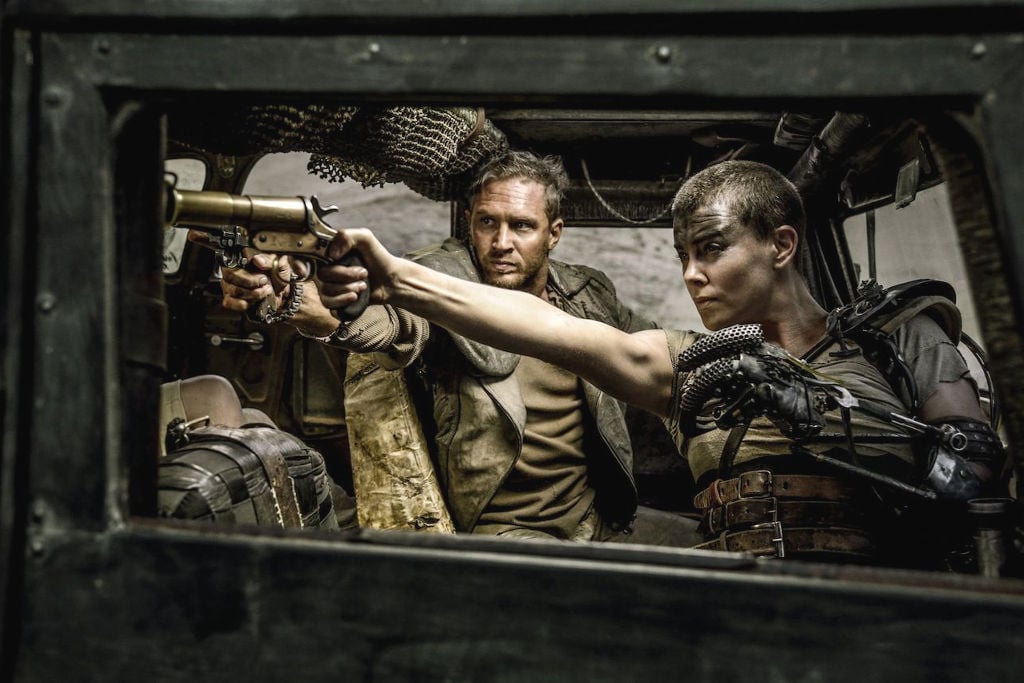Review: ‘Wonder Woman’ Is Both Radical And Radically Fun
'Wonder Woman' is the first DC superhero film to have any bloody fun.
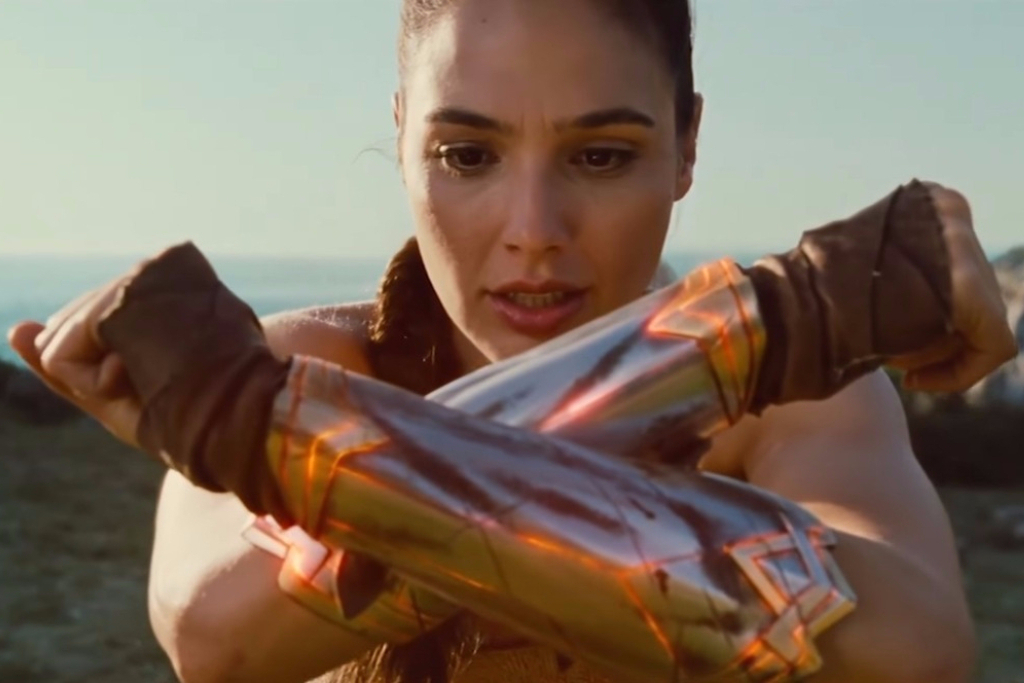
It’s not often that attending an early screening of a film is particularly exciting. Usually a weird mix of the media, competition winners and the general public, these screenings tend to be exciting purely because a) they are free, b) they sometimes come with free popcorn as well. However, the Monday night advance screening of Wonder Woman I attended buzzed with palpable and strange energy. Women and men were decked out in their Wonder Woman finery, and a group of middle-aged women two rows in front of me practically exploded out of their seats when the opening credits rolled.
Wonder Woman is more than just a superhero movie; it’s also the first standalone female-led superhero movie since the ill-fated Elektra, starring Jennifer Garner, and the first live-action Wonder Woman film ever made. Wonder Woman is a big deal to a lot of women (and a lot of men) who grew up with few female role models in the action/comic-book realm.
It’s a tall order for anyone attempting to make magic with the character onscreen, especially considering the calibre of recent DC Extended Universe films released by Warner Bros; but it’s one that director Patty Jenkins and her team absolutely achieve in this Wonder Woman, starring the exquisite Gal Gadot. Astonishingly earnest, zany and hopeful, Wonder Woman is radical not just because of its practically anarchic source material, but because it’s the first DC superhero movie to have any bloody fun.
The Problem Of Women In Action Films
Two years ago, George Miller premiered a highly anticipated (15 years in the making kind of “highly anticipated”) addition to his Mad oeuvre, Mad Max: Fury Road. The film was slated as a return to the scorched deserts, fast cars and chromatic insanity of Mad Max with a brand-new Max at the helm: Tom Hardy (considering Mel Gibson was too literally mad to return). When the film premiered, it turned out to be a classic bait ‘n’ switch. Hardy barely mumbled a word throughout the film, and the real focus was on (the real hero) Charlize Theron’s enigmatic warrior, Imperator Furiosa.
Fury Road was hailed by many (this reviewer included) as a feminist action masterpiece. Finally there was an action film that centred on the struggles of women in worlds dominated by men; a film that did not patronise, did not oversexualise, and did not pander to the female audiences (or the male audiences, for that matter) that it sought to attract. The film itself acted as a kind of allegory for the world of action films: places where men went to seek a kind of “refuge” from having to care about female characters or women’s issues beyond the shriek of a damsel in distress or the waggle of a well-crafted buttock in a pair of hot pants.
In Fury Road, the women broke free from this male-ruled prison and made their own action. Surprise surprise, under the tight editorial eye of Oscar-winner Margaret Sixel, this women-centred action was pretty damn entertaining.
Too bad Fury Road was merely a blip on the radar of the male-dominated action space. The might of Theron’s Furiosa did not usher in a new world of kickass female-helmed action. Action films went back to being just as male-focused and laborious as they were before, and most of the women remained squarely identified as a love interest or damsel first, and a fully-realised individual character second. One bright spot: the Star Wars universe, which gave us the excellent action hero Princess Leia in the 1970s and ’80s, and has doubled down on the feminist fun with two brand-new action superstars, Rey (from Star Wars: The Force Awakens) and Jyn (from Rogue One). The radical thing about Furiosa, Rey and Jyn isn’t just that they’re women in an action film; it’s that the films make those women and their concerns the focus. They’re not standing in the shadow cast by a male lead. They are the leads; they’re casting the shadows.
So Wonder Woman was destined to garner a spotlight (regardless of its quality) simply because it is one of precious few action films led by a woman. Still, it had a lot going against it: there’s the world’s apparent general superhero fatigue, as well as the fact that poor old DC has lagged behind Marvel when it comes to making palatable films that audiences actually enjoy (and critics root for). Despite the fact that Gadot’s turn as Wonder Woman in Batman v. Superman was one of that dreadful film‘s most endearing parts, and that the Wonder Woman trailer looked spectacular when it was released at Comic-Con last year, there was still a huge chance the film could flop. (We’ve all been burned by trailers before.)
Fun On Paradise Island
When we talk about radical moments in film, we often misappropriate the word. Radical doesn’t just mean something is different, or something has changed; it’s a fundamental rearrangement of long-held structures or beliefs. Wonder Woman may not be entirely radical as a general action film; it follows the rote formula that’s by now so well-established that audiences play guessing games about which world city will be destroyed, or when the evil blue light will beam down from the sky. However, tell me what’s more radical than a film beginning with 20 minutes of no men. No men on the screen, no men in conversations, no male-directed romances. Just. No. Men. Ladies, welcome to Paradise Island.
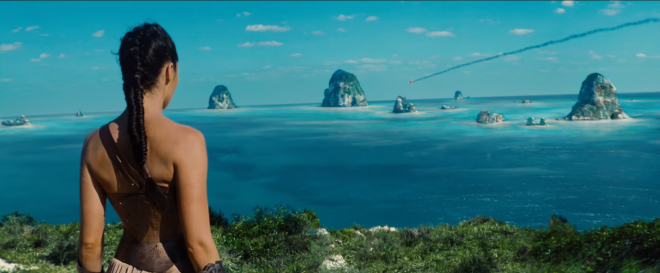
For those unaware, Wonder Woman’s alter ego is Diana, princess of the Amazonian island of Themyscira, which is a world comprised entirely of women warriors. In Wonder Woman, the Amazons were created by Zeus to combat the evil that his son Ares infected humans with, i.e. the desire to fight wars and be generally nasty. The Amazons are supposed to be a “bridge of understanding” for humans; they are fierce warriors, can speak myriad languages and are generally hot babes.
Young Diana grows up as the only child on Themyscira alongside the tribe of adult Amazon women, including the Amazon General/Diana’s aunt, Antiope (Robin Wright, kicking serious butt), and her mother, Queen Hippolyta (Connie Nielsen). It’s not quite clear what Diana’s heritage is (though Hippolyta tells her she carved Diana from clay), but she’s mysteriously significant to the Amazons. She’s also a brilliant warrior with a thirst for combat, but is forbidden from learning fighting skills by her mother (Antiope and Diana subsequently meet in secret to train).
When grown-up Diana (Gadot) is just trotting around Themyscira, taking in her nice man-less surroundings, she watches a plane carrying a soldier crash into the ocean, so she Pocahantas dives into the water to rescue the drowning man. That man is Steve Trevor (Chris Pine) a WWI spy for British Intelligence, who has unintentionally brought a fleet of German soldiers to the well-hidden island. A lot of fighting, and some crafty Truth Lassoing later, Diana (now “Diana Prince”) is on her way to London with Trevor, where Trevor hopes to deliver some information that may change the course of the war for the worse. Diana has tagged along to kill the modern manifestation of Ares and release humans from the desire to fight and kill each other, natch.
There was something intrinsically arresting about seeing so many strong female bodies on screen — women fighting, working, ruling together.
The plot is mind-numbingly silly, but it hardly matters; you just sit back and let it wash over you. WWI influenced by the spirit of a Greek god? Sure. A magical mustard gas that can penetrate gas masks and set alight the entire Western Front? Whatever. Oddly, I find that these films work their best (and silliest) when history is reimagined as being influenced by these mythical beings (who in some cases have influenced our real history as well). Most of the moments of genuine humour and zany slapstickery that keep the film chugging along come from the Goddess-like Diana butting up against the priggish sensibility of early-1900s England. The others come from the electric connection that crackles between Gadot and Pine.
Still, I was somewhat overwhelmed, before the film descended into General Action Flick territory, by the incredible setting of Themyscira. The island is presented as a functioning, flourishing paradise (Pine’s Trevor even jokingly calls it “Paradise Island”). When Trevor and the soldiers arrive, that paradise is disrupted and destroyed, and the women are forced to fight to defend the society they have built. It’s hard not to see the allegorical radicalism in this setting: a paradise created by women, destroyed by men.
The Amazons’ very function, after all, is to keep cruel warmongering men in line, and Diana herself is deployed to clean up the mess of the Great War. There was something intrinsically arresting about seeing so many strong female bodies on screen — women fighting, working, ruling together. I was reminded of Megan Gale and her women warriors in Fury Road, and again of how radical it feels to watch women fight and win in an arena where so often they are sidelined or completely ignored.
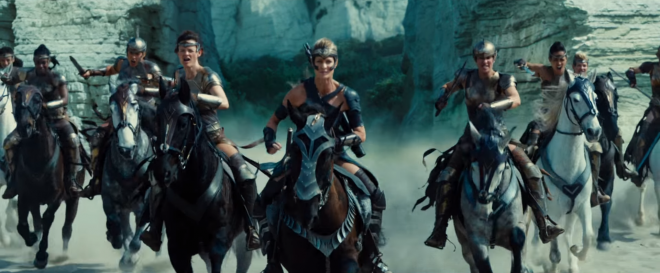
The Wonder Of Gal Gadot
As for Wonder Woman herself, Gadot is a striking star and a top-notch addition to the now fairly middling pantheon of DC superheroes. You can see now how easily she lifted the dirge that was Batman v. Superman. While Cavill and Affleck growl and furrow their brows she bounces effortlessly in frame, with her ease of manner, infectious optimism and impeccable comedic performance.
In Wonder Woman, Gadot is sharp and quick-witted; she also has wonderful physicality, both as a fighter and a jokester. It doesn’t hurt that she’s lithe and exquisitely beautiful (although I wish she’d kept her hair in that braid when fighting) — so gorgeous you believe every word of world-building nonsense she speaks. She feels so fresh, so untarnished by the embattled DC brand and the oppressive darkness in which the studio drenches their films. Your eye is drawn to hers; you believe in her Wonder Woman.
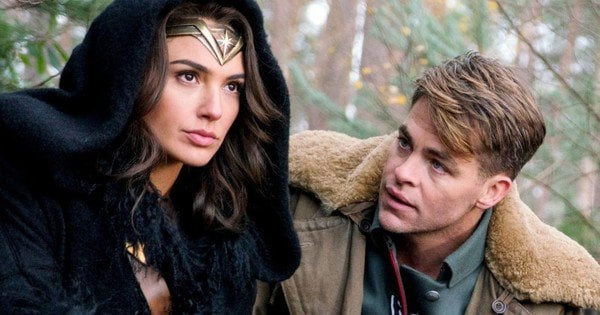
The lightness of the film is made more stark by the presence of Chris Pine, who is unquestionably the most underrated Hollywood Chris. Pine is devilishly handsome and charming. He carries off both a crooked smile and a literal twinkle in his piercing blue eyes (even if he is constantly tossing back his ridiculous, anachronistic honey-coloured fringe). He and Gadot have buckets of chemistry, and they do a good job navigating the complicated position of planting romance inside a feminist allegory.
Again, Wonder Woman has what many other action films (and superhero films) are missing: talented, chemistry-cast leads; exciting action (Wonder Woman charging across No Mans’ Land on the Western Front is as startling as it looks in the trailers); and thrilling villains to antagonise our heroes. Lucy Davis, who plays Trevor’s secretary Etta, also supplies some wonderful zip to the sometimes plodding, exposition-led scenes in London.
True, the film ends up where all action films do these days: a melange of CGI, glowing lights in the sky and thunderous crashes that we now understand to be a “climax”. But Gadot serves all the strength and openness that have encouraged you to root for her Diana, and I found that I was more engaged by this by-the-numbers final action piece than I could have been. It’s in large part down to the central thesis of Wonder Woman, which taps into the enduring success of the X-Men stories (most clever millennials’ favourite superhero narrative), an irrepressible hopefulness. This is really what makes a hero — not muscles or superpowers or a gravelly voice.
–
Wonder Woman is in cinemas now.
–
Matilda Dixon-Smith is Junkee’s Staff Writer. She tweets at @mdixonsmith.
